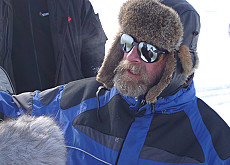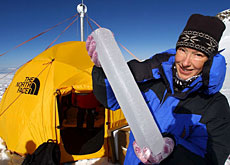Performing ice-cold arctic calculations

Swiss scientists are conducting chilling research within the Arctic Circle that is crucial for climate forecasting, as a visit by swissinfo reveals.
In both Greenland and the world’s northernmost settlement, it boils – or melts – down to the unknown consequences of the rapid shrinking of polar ice sheets and sea ice.
It’s white as far as the eye can see. And deathly cold. At Greenland’s “Swiss Camp”, leading scientist Konrad Steffen uses his bare hands to reconnect a wire of an automated atmospheric station.
This metal turret planted in the ice cap measures temperatures, wind speed and precipitation. Information from more than 30 of these instruments linked to satellites is transmitted every hour to Steffen.
“Koni”, as Steffen is known, set up Swiss Camp for the Federal Institute of Technology in Zurich in 1990. But Koni and his research have moved on.
As head of the environmental sciences institute at the University of Colorado and a member of numerous international climate committees, Koni has his Greenland work funded by Nasa. The interest of the US government’s National Aeronautics and Space Administration speaks volumes about the importance of his work.
If the Greenland ice sheet were to melt completely, sea levels would rise seven metres. “Already, the island loses more ice than is being replenished through precipitation,” Koni told swissinfo.
“This recent development is happening faster than models have predicted, and the loss each year exceeds the total glacial mass of the Alps,” he explained. “The main question is: how will it continue?”
Big melt
Research by Koni and his team has confirmed an increasing trend in melting since 1979 and the speeding up in the 1990s of the decline of arctic glaciers and ice caps.
“The temperatures constantly increased over the past 17 years,” Koni said. “And the biggest increase occurs in winter. The weather is now five degrees Celsius warmer than in 1990.”
As part of his work into how the climate is interacting with ice masses, Koni has recorded increasing amounts of melt water flowing into the ocean, and therefore decreasing the reflection of the sun.
The Swiss scientist warns that this year’s report by the Intergovernmental Panel on Climate Change has underestimated the forecast for the rise in ocean levels (200-500mm by the year 2100).
He says a “dynamic response of ice sheets” can lead to much greater uncertainty with a rise of up to one metre by the end of the century. “That’s significant when you realise how many people live close to the coast.”
Thermal expansion
But it is not only land-based ice that leads to higher sea levels. The other major cause is thermal expansion of the oceans since water expands as it gets warmer.
Sébastien Barrault, from Sion in canton Valais, is studying the properties of sea ice at Norway’s Svalbard University, located in Longyearbyen on the remote Svalbard archipelago.
“The ice is approximately 60 centimetres thick, which is only half what it was a couple of years ago,” said Barrault, who is doing his PhD on the impact of temperature on the property of marine ice.
He says it is puzzling that while snow fell in abundance this past year it did not freeze and add to the layer of ice.
“The ice would have broken under the weight of a cat at the beginning of March, which is unusual during that period,” he says, even if he doesn’t know whether there is a direct link to global warming.
Barrault’s studies are key to understanding how sea ice responds under a variety of conditions. This is important for oil companies, for example, since unpredictable ice flows could destroy oil platforms, causing an environmental disaster.
So far the only conclusion that Barrault can draw is that sea ice – made up of brine, pure ice and seawater – is “capricious”, meaning scientists are still divided over whether it expands or retracts before melting as temperatures rise.
Barrault hopes his measurements can provide some of the answers.
swissinfo, based on articles by Pierre-François Besson and Luigi Jorio
The Swiss scientific community founded the Swiss Committee on Polar Research (SCP) in 1984.
The SCP supports research in both the Arctic and Antarctic and is an information platform designed to stimulate interdisciplinary contacts.
Scientists belonging to the committee are involved in multilateral European research programmes, including ongoing research into Antarctic ice cores.
“Swiss Camp” was set up in the west of Greenland by Konrad Steffen and his colleagues from the Federal Institute of Technology in Zurich in 1990.
The nearest settlement, Ilulissat, is 70km away. At 1,100m above sea level on top of the ice cap, the camp is on the edge of the line marked by winter snowdrift and summer snow.
Recent data obtained by Swiss Camp confirm the rise of temperatures and the accelerated movements of the ice sheets.
Svalbard consists of a group of islands in the Arctic Ocean, north of mainland Europe. Three islands are inhabited: Spitsbergen, Bjørnøya and Hopen.
The largest settlement is Longyearbyen; the smallest, a Norwegian weather station in Hopen, has a population of four.
As part of his geophysics course at Svalbard University in Longyearbyen, Sébastien Barrault is conducting research for his doctorate on the thermal properties of sea ice.

In compliance with the JTI standards
More: SWI swissinfo.ch certified by the Journalism Trust Initiative














You can find an overview of ongoing debates with our journalists here . Please join us!
If you want to start a conversation about a topic raised in this article or want to report factual errors, email us at english@swissinfo.ch.